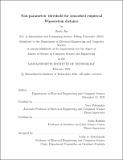Non-parametric threshold for smoothed empirical Wasserstein distance
Author(s)
Jia, Zeyu
DownloadThesis PDF (635.4Kb)
Advisor
Polyanskiy, Yury
Rakhlin, Sasha
Terms of use
Metadata
Show full item recordAbstract
Consider an empirical measure P𝑛 induced by 𝑛 iid samples from a 𝑑-dimensional 𝐾-subgaussian distribution P. We show that when 𝐾 < 𝜎, the Wasserstein distance 𝑊₂² (Pₙ*𝒩(0, 𝜎² 𝐼 subscript 𝑑), P*𝒩 (0, 𝜎² 𝐼 subscript 𝑑)) converges at the parametric rate 𝑂(1/𝑛), and when 𝐾 > 𝜎, there exists a 𝐾-subgaussian distribution P such that 𝑊₂² (Pₙ *𝒩 (0, 𝜎² 𝐼 subscript 𝑑), P* 𝒩 (0, 𝜎² 𝐼 subscript 𝑑)) = 𝜔(1/𝑛). This resolves the open problems in[7], closes the gap between where we get parametric rate and where we do not have parametric rate. Our result provides a complete characterization of the range of parametric rates for subgaussian 𝑃.
In addition, when 𝜎 < 𝐾, we establish more delicate results about the convergence rate of W2 distance squared. Assuming the distribution is one dimensional, we provide both the lower bound and the upper bound, demonstrating that the rate changes gradually from Θ(1/√ 𝑛) to Θ(1/𝑛) as 𝜎/𝐾 goes from 0 to 1. Moreover, we also establish that 𝐷ₖₗ(Pₙ * 𝒩 (0, 𝜎² 𝐼 subscript 𝑑)‖P * 𝒩 (0, 𝜎² 𝐼 subscript 𝑑)) = 𝒪˜(1/𝑛). These results indicate a dichotomy of the convergence rate between the W2 distance squared and the KL divergence, resulting in the failure of 𝑇₂-transportation inequality when 𝜎 < 𝐾, hence also resolving the open problem in [17] about whether 𝐾 < 𝜎 is necessary in proving whether the log-Sobolev inequality holds for P * 𝒩 (0, 𝜎²).
Date issued
2022-02Department
Massachusetts Institute of Technology. Department of Electrical Engineering and Computer SciencePublisher
Massachusetts Institute of Technology